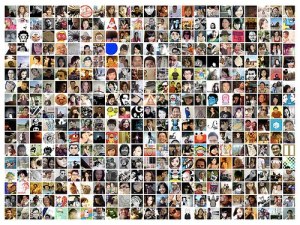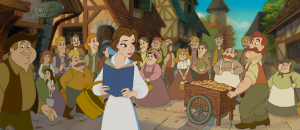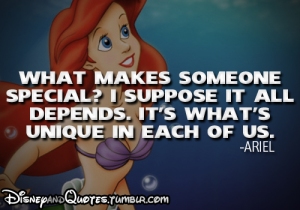Hello!
So final entry before the synthesis blog, SCARY! I feel like I have a 1001 things left to say, but on the tip of my tongue right now is the idea of ‘community’.
Last week I mentioned cyber bullying. If our bullies are now online and so are our friends, shops, clubs and parents, is our entire community not now a series of online interactions?
Ainsworth (2002) has suggested that community places a role in education. It is suggested that the community in which a child grows up in will influence a child’s educational goals and motivation to learn (Andrews, Garfinkal, Parker, Perry & Rauh, 2003).
If you’re anything like me, your ideal concept of community will be something like this:
A whimsical, nurturing, disneyesque series of cute interactions and singing animals. However, Zaidieh (2012) suggests that our actual community is more like this:
 A mass of online communications in the form of clicks, tweets, likes and pokes.
A mass of online communications in the form of clicks, tweets, likes and pokes.
This shift in community has occurred not only for physical communities, but for academic communities too. Zaidieh argues that online communities allow students to learn through interaction with online friends/personas. However, these personas may not always be genuine. It is argued that being able to change one’s identify allows students to overcome fears of social perception and educational anxiety. In addition, Zaidieh suggests that as students spend copious amounts of leisure time on social media, online communities have a greater impact on extra curricular learning than their classroom environment.
Social media in education causes an increase in collaborative learning. Frechette (2013) found that online based learning programmes had a higher rating of community than the traditional classroom. Furthermore, Frechette has suggested that a strong sense of online academic community (OAC) encourages this collaborative learning, resulting in an increase in class discussion and conceptual understanding. Social media in education shifts educational power to students, allowing them to become “authoritative producers of knowledge”. When students are encouraged to explore information themselves, and share this with their OAC, they demonstrate more motivation in their learning, thus helping education extend from the classroom to extra curricular learning. Frechette argued that increasing community through social media decreases the authority of an educator, this is seen as beneficial, as collaborative learning through videos and blogs develops understanding more effectively than an autocratic teaching system.
Orlando (2010) suggests that each student has a personal learning environment (PLE), a topic or interest they enjoy. This implies that learning can be encouraged by linking education to personal relevance. In many cases, this link remains relevant, for example, if a student is interested in medicine, but is studying Native American history, they should be given opportunities to discuss and evaluate the healthcare of Native American tribes in their blogs. Orlando argues that a student’s individual PLE will shape their OAC. Social media allows students to select what OACs they compile information from, based on their PLE. As the web is incredibly vast and rich in information, a student’s educational community can consist of scholars and students around the world with similar interests.
Jenkins (2008) suggests that our academic communities create a collective intelligence (CI). CI refers to the combination of knowledge provided by all members of an academic community. An example of CI is our class. We all have various interests and various degrees of knowledge in our education, some of us research feedback, some research technology and some people research grading etc. Although we may not be educational experts, individually the combination of our communities’ knowledge is impressive. CI suggests that students have the ability to both contribute their individual knowledge and retrieve knowledge from their community. Social media causes online communities to be larger, and therefore greater in CI, allowing students to absorb more information. Jenkins argues that OACs face academic problems together; for example, Wikipedia allows users to edit information, therefore community members interested in particular areas can collaborate information in order to increase their CI, which can thus increase the individual knowledge of community members.
Finally, OACs have been suggested to make education accessible to everyone. Jenkins argues that we are motivated by community, students who do not have a motivational home environment, can instead be motivated by the community they have chosen as a result of their PLE. Furthermore, Frechette argued that social media allows community to go above class, race and socioeconomic standing. This means that all students have an equal opportunity to learn, and that they can learn in a community regardless of their academic ability.
In conclusion, a student’s community can aid or hinder their education, be it offline or online. The social media revolution can motivate students to learn beyond the classroom around their personal learning environment. A student’s individual goals and learning can be direct through social media to form an online academic community, and this allows students to access large amounts of knowledge from their community intelligence. Above all, social media can generate an academic community that enhances collaborative learning to aid a student’s conceptual understanding, with each individual learner, providing their own insight and learning from someone else.
Thanks for reading!
*****
References
Ainsworth (2002): http://ajph.aphapublications.org/doi/abs/10.2105/AJPH.94.3.440
Andrews et al (2003): http://onlinelibrary.wiley.com/doi/10.1002/jcop.10049/abstract
Zaidieh (2012): http://wcsit.org/pub/2012/vol.2.no.1/The%20Use%20of%20Social%20Networking%20in%20Education%20Challenges%20and%20Opportunities.pdf
Frechette (2013): http://journalofmedialiteracy.org/index.php/current-issue/98-david-considines-ten-technology-tips-for-principals
Orlando (2010): http://www.facultyfocus.com/articles/edtech-news-and-trends/personal-learning-environments-help-students-extend-learning-beyond-the-classroom/
Jenkins (2007): http://www.idunn.no/ts/dk/2007/02/confronting_the_challenges_ofparticipatoryculture_-_media_education_for_the?languageId=2


Hellooo 🙂
First of all I just want to agree with you on the ideal concept of community.
Secondly, it has been found that there are gender differences with regards to the degree of influence with in an on-line learning community. Rovai and Baker (2005) found evidence that through a graduate level on-line learning course females feel more connected to other students on their course, they felt that their on-line learning experience was closer to their goals and values and they also perceived that they had learned more than their male peers.
http://www.eric.ed.gov/ERICWebPortal/search/detailmini.jsp?_nfpb=true&_&ERICExtSearch_SearchValue_0=EJ874987&ERICExtSearch_SearchType_0=no&accno=EJ874987
Thanks for your comment
It’s something I hadn’t thought off. Sullivan (2010) argues that online community’s are more beneficial to female students who value large online social reaction over small face to face discussion. The research suggests that male students benefit more from physical interaction than their female counterparts. Interesting research by Young and McSporron (2001) suggests that female students are better at creative learning, that moves away from a strict class instruction. In addition Young and Mc Sporron suggest that male students require a strict learning environment in order to schedule their own learning. The implications here suggest that perhaps online (social media) learning is beter for female students than males, therefore may be better implemented in same-sex schools.
In addition, both these papers identify a benefit for mature students in online learning which is something that could be explored.
http://www.editlib.org/p/8967/
http://www.tandfonline.com/doi/abs/10.1080/106689201753235930
Young and McSporran (2001) found that the use of on-line courses seemed to be more beneficial to women and older students who are more organised and better at managing their time, are more motivated and are better at communicating on-line. The male and younger students need the discipline that a classroom based lesson can offer. this is possibly due to the fact that they approach things with over confidence. Research by Sullivan (2010) supports this, stating that on-line courses are of particular benefit to non traditional students such as female adult learners with a children or some sort of family responsibility.
http://www.editlib.org/p/8967/
http://www.tandfonline.com/doi/abs/10.1080/106689201753235930
Hi,
Of course, teachers are (apparently) people too and are well aware of social media, and the majority use the sites for both personal and professional reasons. It seems logical that they should utilise their benefits (much like this module i guess!)
Moran et al, (2011) posed a few question a group of teaching staff regarding their use of social media during class, outside class, and about use as part of student assignments. Results showed that faculty do make considerable use of social media in their teaching: nearly two-thirds of participants had previously used social media as a learning tool during class time and 30% had posted content for students to view outside class.
It was also found that online video is by far the most common type of social media used in class and posted outside class for student use. Podcasts and blogs are next in popularity, closely followed by those sites that we’re oh too familiar with (e.g. facebook/twitter) but these were more often used off the students backs, rather than suggested by teaching staff. We see examples of this at Bangor – most of my modules this year have had a facebook group to allow discussion with peers.
As you’ve suggested, communities can prove both a help or hindrance. But surely …two (or many, many more) heads are better than one 🙂
Sources & References:
Moran, M., Seaman, J., & Tinti-Kane, H. (2011). Teaching, Learning, and Sharing: How Today’s Higher Education Faculty Use Social Media. Babson Survey Research Group.
Another great blog on social media learning. I agree, collaborative learning becomes increasingly important in the information driven era. As findings suggest, there is a great effect of online learning networks since through such platforms are a promotion of an interaction between student and instructor, it encourages students to works together, and can generate participants to be active (Hiltz et al, 2002). There are several findings which suggest that online collaborative learning has the same impact as face-to-face learning, in particular evidence of social presence being developed and self-inefficiency (Francescato et al., 2006). But there is also critical evidence to it, which states that on line communities create less feelings of trust and interaction (Cardieux, 2002). However, I believe there are a lot of benefits in collaborative online learning, which can be seen in this module.
References
http://dl.acm.org/citation.cfm?id=505273
http://www.sciencedirect.com/science/article/pii/S0747563205000385
http://www.eric.ed.gov/ERICWebPortal/search/detailmini.jsp?_nfpb=true&_&ERICExtSearch_SearchValue_0=ED474545&ERICExtSearch_SearchType_0=no&accno=ED474545